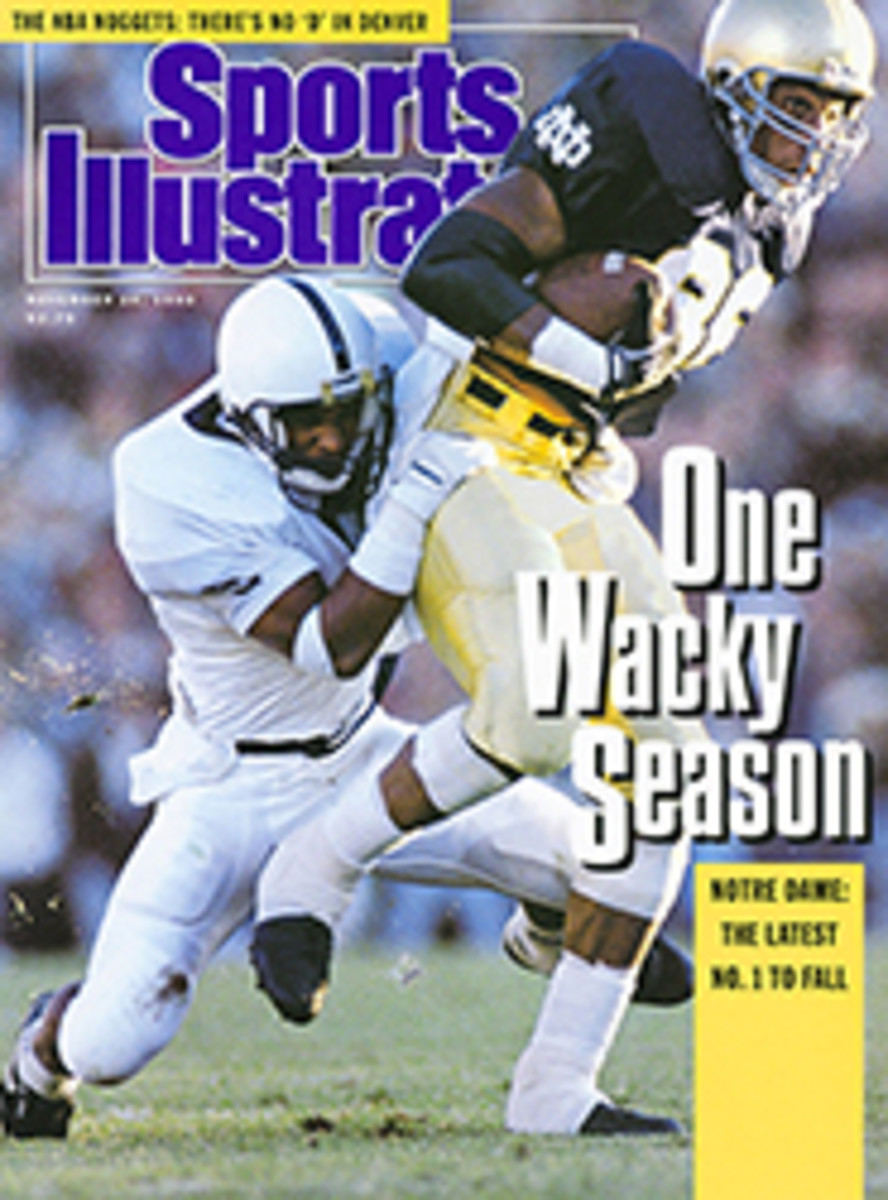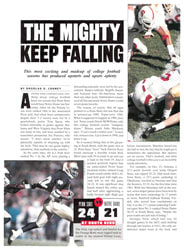
BLUE HEAVEN
Even when the St. Louis Blues were doing well to win as many games as they lost, it could not be said that general manager Ron Caron took defeat sitting down. In fact, at one point during a game last year in Toronto, there was literally no place for Caron to sit. He had hurled his chair 10 feet across the press box in protest of a referee's failure to call a penalty on the Maple Leafs that resulted in a Toronto goal.
Caron's tantrums are well known in the NHL. He once kicked a hole in the wall of the Chicago Stadium press box. Another time he threatened to throw a lap-top computer onto the ice and fire the Blues assistant coach who was using it to record game data. Over the years, Caron has insulted league supervisory officials, challenged sportswriters and opposing club officials to fights and screamed epithets at the other teams' players.
So when the Blues lost a goal, and ultimately the game, in overtime on Nov. 1 because a goal judge in Boston failed to acknowledge that the puck had entered the net, it was assumed that Caron would start a tea party in the Boston Garden press box. He didn't. Oh, his face turned the color of his team's jerseys, and he muttered his way over to referee supervisor John D'Amico to complain. But neither a chair, a jacket nor even a pen was hurled in the press box.
"I have done some soul-searching," says Caron. "There won't be any more chairs. This is finished." Caron, nicknamed The Professor because he once taught French and English in a junior college in Quebec City, has a siren for a voice. It features pitches that fluctuate between high and higher, a Gallic accent and the cadence of an offbeat rumba band. "I have friends who have told me it was time to stop, and I did not have to be convinced," says Caron. "But if you say I am in a good mood because of my team, I could not disagree with you."
Indeed, the Blues are giving Caron good reason to be mellow. That defeat in Boston was one of just two losses in a 15-game stretch (12-2-1) through Sunday night, a run that lifted St. Louis to the best start in its 24-year history (14-5-1). After beating the Quebec Nordiques 4-2 and the Minnesota North Stars 3-2, the Blues lost to the Winnipeg Jets 4-3 to end the week and trailed the first-place Chicago Blackhawks in the Norris Division by three points, though they had played three fewer games.
This is remarkable success for a franchise whose logo, a blue note, was generally considered to be a flat. It is also vindication for Caron, an eccentric, driven, yet generally affable man who has wheeled and dealed St. Louis—a team that has advanced past the second round of the playoffs only once in the past 20 years—into a Stanley Cup contender.
"I would prefer to trade my first quarter for my last quarter," says Caron, meaning he's always thinking of the future. Still, for several seasons after taking over the rundown Blues in 1983, all the quarters that Caron juggled left him with a 25-cent team. Recent successes have suggested that one should not take lightly a man who once said, "You cannot be going north when you are going south. This is an eternal truth." Never mind whether this makes any sense. The eternal truth of sports is defined by your won-loss record, and Caron is fully responsible for the record now owned by St. Louis.
Brett Hull, an overweight underachiever when Caron acquired him from the Calgary Flames in 1988 for defenseman Rob Ramage and goalie Rick Wamsley, has emerged as one of the game's most dynamic players. Hull's 72 goals last season and his pending free agency forced the Blues to cough up a $7.1 million, four-year contract on June 9. The money has not turned Hull fat and lazy again. At week's end, his 21 goals led the NHL.
On July 5, Caron signed free-agent defenseman Scott Stevens to a four-year, $5.1 million contract, unprecedented money for a player who is not a gate draw. Other clubs moaned that Stevens's contract would break the league's salary structure, and they questioned whether the 26-year-old Stevens could do what the Blues expected of him—raise St. Louis from an average club to one of the elite. Stevens, rugged and offensively skilled but often inconsistent when he was a Washington Capital, has provided the Blues with the physical presence and puck movement they had hoped for. He has also emerged as a leader and was named team captain before the season began.
Last December, Caron traded goalie Greg Millen and center Tony Hrkac to Quebec for Jeff Brown, a talented 24-year-old defenseman who was under suspension for lackadaisical play. Brown, the kind of offensive defenseman a contender needs, has a superior shot, which he used on Nov. 12 to beat goalie Ron Tugnutt from a difficult angle in the victory over the Nordiques. Now coach Brian Sutter is trying to teach Brown defensive responsibility by pairing him with Stevens. When Stevens joins the play on offense, Brown has to stay back. Brown's point total is suffering as a result, but his overall effectiveness is improving.
Thus Caron has obtained Hull, a game-breaking scorer; Stevens, a steady, all-around defenseman; and Brown, the point man for the power play. And when one continues down the list of ingredients that make a winner, it becomes even more obvious that Caron has been on an uncanny trading roll. The day after Stevens became a Blue, Caron acquired left wing Geoff Courtnall from Washington for center Peter Zezel and defenseman Mike Lalor. Courtnall was one of the three Capitals who had been investigated by a grand jury for an alleged sexual assault of a 17-year-old girl in a car outside a Georgetown bar. Though the jury cleared the players, the publicity over the incident had left their reputations tainted. "In the back of my mind, I thought it was probably best that I be traded," says Courtnall. Caron thought it was a good idea too, because Courtnall, who had 10 goals for the Blues as of last weekend, added speed and a consistent scoring threat from the left wing.
But Caron's best trade may have been the one in which he acquired Adam Oates, a playmaking center who came from the Detroit Red Wings with winger Paul MacLean in June 1989 for center Bernie Federko and winger Tony McKegney. After one year with the Red Wings, Federko, 34, retired; McKegney is currently playing for Quebec. Last season, Oates, now 28, finished 11th in the league in scoring, with 102 points.
On the deficit side, St. Louis will have to give up its first-round choice in each of the next five years in compensation to Washington for signing Stevens; the Blues can avoid that scenario only if Caron is able to trade for picks in the top seven overall selections in the next two drafts and hand them over to the Capitals. Still, the Blues are a young team (Rod Brind'Amour, a rookie last year, is a potential star) with several prospects in their system, the result of Caron's astute picks in the last few drafts. Caron also believes that second-round picks can be as fruitful as late first-rounders; now that St. Louis has risen to power, that is the best Washington can expect from those five first-rounders.
Besides, it was time that the Blues, who had operated on an extremely tight budget under previous owner Harry Ornest (he sold the team in 1986), spent some money and took some chances. The St. Louis market is ripe for a winning team. The football Cardinals moved to Phoenix in 1988. The baseball Cardinals, the town's true sporting soul, finished last in the National League East in 1990 and are rebuilding. To pay for the Hull and Stevens contracts, the prices of tickets to Blues games have been raised an average of $4.50; still, the team is averaging 96% of capacity in the creaking, old 17,188-seat St. Louis Arena. A proposal for a new arena is pending and the Blues' newly found popularity justifies the construction of one.
"The atmosphere is so different now," says Paul Cavallini, an underrated defenseman now in his fourth season with St. Louis. "We finally have upper-echelon players who attract attention."
Except for the Los Angeles Kings' Wayne Gretzky and the Pittsburgh Penguins' Mario Lemieux, no NHL player has a higher profile than Hull, whose father, Bobby, was the greatest left wing in NHL history. The Flames, who considered Wamsley and Ramage the two finishing pieces on their 1989 Stanley Cup-winning team, now insist they knew they were trading a future scoring star in Hull. But at the time of the deal, Calgary had pegged Hull as a floater who would score 40 goals but would be a defensive liability. After Hull got 41 goals in his first full season with the Blues, Sutter and assistant coach Bob Berry called him in for a meeting. "I thought they were going to tell me I had a great season," Hull says. "Instead, they said that 41 goals for me was nothing. I thought if they had that much respect for my ability, I would show them what I could really do."
He went on an extensive off-season training program, lost eight pounds, added some muscle and last season scored 72 goals, the most ever by a right wing. Hull thereby earned both a huge contract and the responsibility of leading the Blues. "After telling myself all summer that I was still going to be myself, I started training camp and panicked," says Hull. "I didn't know if I could handle this. Then the season started, and I just started scoring and I was fine."
Hull's forte is lurking behind the play, jumping into a hole in the defense and releasing either one of the league's quickest wrist shots or hardest slap shots. He has both. But now he has become a more complete offensive threat, a player who can carry the puck and initiate the action.
In the game against Quebec, the Blues were struggling until Hull took over. With the score tied 2-2 (Hull had gotten a goal in the first period) and less than two minutes remaining in regulation time, he took a pass at center ice, got a step outside on defenseman Craig Wolanin and cut toward the net. Tugnutt stopped the shot and Brind'Amour's rebound attempt, too, but the puck bounced back to Hull, who was on the goalie's left. Though Hull's momentum was taking him toward the goal line, worsening his angle as he drifted, he waited for the bouncing puck to lie flat on the ice. When it finally did—and with Tugnutt prone and desperately reaching his glove skyward—Hull wristed the puck into the only place in which it could have hit the net, just inside the juncture of the far post and crossbar.
It was the kind of game the old Blues probably would have tied, but now they are a team with winning talent. Hull did what a superstar is supposed to do with the last shot. Win the game. That's why the fans are buying seats in St. Louis these days. And why Caron is no longer throwing them.
PHOTO
DAVID E. KLUTHO
Like most teams, Quebec had difficulty sticking it to Hull.
PHOTO
DAVID E. KLUTHO
Courtnall's touch around the net was one reason Caron obtained him from the Capitals.
PHOTO
DAVID E. KLUTHO
Caron, the architect of the new Blues, has built a Stanley Cup-caliber team in St. Louis.
PHOTO
DAVID E. KLUTHO
So far this season, Stevens (left) and the Blues have stayed on top of their opponents.

